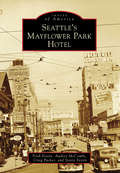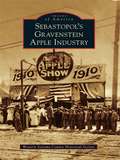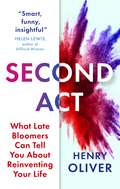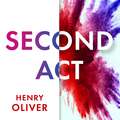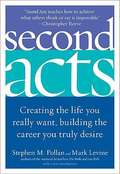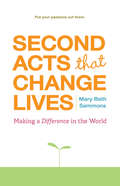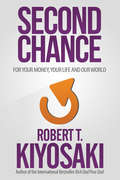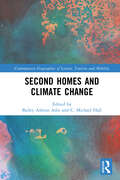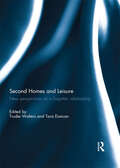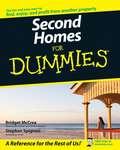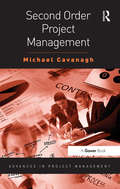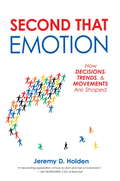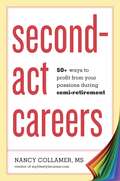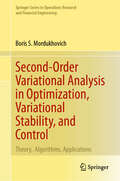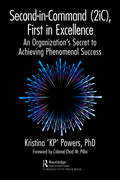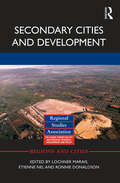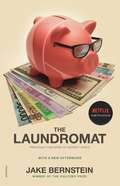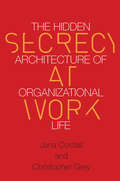- Table View
- List View
Seattle's Mayflower Park Hotel (Images of America)
by Craig Packer Stevie Festin Audrey Mccombs Trish FestinThe Mayflower Park Hotel started life as the Bergonian Hotel on July 16, 1927. One of Seattle's first uptown hotels, it was designed by architect B. Dudley Stuart and built by Stephen Berg at a cost of $750,000. In the midst of the Great Depression, the hotel was sold and renamed Hotel Mayflower. In 1948, Washington State legalized cocktail lounges, and the Hotel Mayflower became Seattle's first hotel to open one. In the ensuing decades, Seattle prospered, and it hosted the 1962 World's Fair with its symbolic Space Needle. By the 1970s, Seattle was in a deep recession, and the hotel had become sadly neglected. In 1974, Birney and Marie Dempcy formed a limited partnership to purchase the hotel and renamed it the Mayflower Park Hotel. Restoration started immediately, and after 40 years, the Dempcys remain dedicated to the tradition of making the Mayflower Park Hotel "Quite Simply, One of a Kind."
Sebastopol's Gravenstein Apple Industry
by Western Sonoma County Historical SocietyThe Gravenstein apple has been etched into the identity of Sebastopol, California, which is one of the few places on earth to have extensively grown this elusive apple. The Gravenstein is an early apple whose only failing is perishability, but it is celebrated for its superior flavor. Yet Luther Burbank attempted to improve on the Gravenstein, producing the Winterstein and the Bonita for home gardeners. During the last 127 years, the Gravenstein has added millions of dollars to the local economy. It has provided a reason for celebrations, from the 1910 Apple Show to today's Apple Blossom Festival and Gravenstein Apple Fair. This is the Gravenstein's story, from its European roots to small-town homage, and the part this special apple has played in one community--and the reason the current decline in apple acreage is mourned.
Secom: Managing Information Security in a Risky World
by Robert D. Austin F. Warren Mcfarlan Robert O. AustinExamines the type of security that is appropriate for an Internet company to have on its site. Focuses on a 20-person electronic e-commerce company trying to decide what parts of the information security product line they should acquire from the largest security service company in Japan, Secom. The services include everything from server hosting, advanced housing, firewall intrusion detection, etc. Introduces the wide range of products that can be used to ensure secure operations.
Second Act: What Late Bloomers Can Tell You About Success and Reinventing Your Life
by Henry Oliver"Henry Oliver is a rare talent: smart, funny and insightful. SECOND ACT showcases his wide reading, deep understanding and playful prose style. Read this book to discover why it's never too late for a second act in your own life."HELEN LEWIS, author of Difficult WomenHave you ever dreamed that you might be far more successful than you are today? Our society tells us over and over that if we're going to achieve anything, we'd better do it while we're young. But whether you're at the start of your career, sensing you're on the wrong path, or feeling unsettled later in life, you're likely wondering just how to reinvent yourself? Have you left it too late?This book has answers. Late bloomers - individuals who experience significant success later in life - offer lessons for people who feel frustrated. This book encourages people to think about themselves as potential late bloomers and to discover and encourage and advocate for late blooming in others. After all, it's never too late to discover our hidden talents and our accomplish our goals - the road to success is never as straightforward as we are lead to believe. Julia Child didn't discover that she loved to cook until she was thirty-seven. Vera Wang started her design business at forty. And Michelangelo painted The Last Judgment in his sixties.This inspiring, passionate book combines wonderful storytellingwith fascinating new research, to shift expectations around our life trajectories. You'll discover a range of blueprints for self-reinvention, pairing the newest insights from psychology and neuroscience with late bloomers' remarkable life stories, from Penelope Fitzgerald to Samuel Johnson, from Frank Lloyd-Wright to Malcolm X.
Second Act: What Late Bloomers Can Tell You About Success and Reinventing Your Life
by Henry Oliver"Henry Oliver is a rare talent: smart, funny and insightful. SECOND ACT showcases his wide reading, deep understanding and playful prose style. Read this book to discover why it's never too late for a second act in your own life."HELEN LEWIS, author of Difficult WomenHave you ever dreamed that you might be far more successful than you are today? Our society tells us over and over that if we're going to achieve anything, we'd better do it while we're young. But whether you're at the start of your career, sensing you're on the wrong path, or feeling unsettled later in life, you're likely wondering just how to reinvent yourself? Have you left it too late?This book has answers. Late bloomers - individuals who experience significant success later in life - offer lessons for people who feel frustrated. This book encourages people to think about themselves as potential late bloomers and to discover and encourage and advocate for late blooming in others. After all, it's never too late to discover our hidden talents and our accomplish our goals - the road to success is never as straightforward as we are lead to believe. Julia Child didn't discover that she loved to cook until she was thirty-seven. Vera Wang started her design business at forty. And Michelangelo painted The Last Judgment in his sixties.This inspiring, passionate book combines wonderful storytellingwith fascinating new research, to shift expectations around our life trajectories. You'll discover a range of blueprints for self-reinvention, pairing the newest insights from psychology and neuroscience with late bloomers' remarkable life stories, from Penelope Fitzgerald to Samuel Johnson, from Frank Lloyd-Wright to Malcolm X.
Second Act: What Late Bloomers Can Tell You About Success and Reinventing Your Life
by Henry Oliver"Henry Oliver is a rare talent: smart, funny and insightful. SECOND ACT showcases his wide reading, deep understanding and playful prose style. Read this book to discover why it's never too late for a second act in your own life."HELEN LEWIS, author of Difficult WomenHave you ever dreamed that you might be far more successful than you are today? Our society tells us over and over that if we're going to achieve anything, we'd better do it while we're young. But whether you're at the start of your career, sensing you're on the wrong path, or feeling unsettled later in life, you're likely wondering just how to reinvent yourself? Have you left it too late?This book has answers. Late bloomers - individuals who experience significant success later in life - offer lessons for people who feel frustrated. This book encourages people to think about themselves as potential late bloomers and to discover and encourage and advocate for late blooming in others. After all, it's never too late to discover our hidden talents and our accomplish our goals - the road to success is never as straightforward as we are lead to believe. Julia Child didn't discover that she loved to cook until she was thirty-seven. Vera Wang started her design business at forty. And Michelangelo painted The Last Judgment in his sixties.This inspiring, passionate book combines wonderful storytellingwith fascinating new research, to shift expectations around our life trajectories. You'll discover a range of blueprints for self-reinvention, pairing the newest insights from psychology and neuroscience with late bloomers' remarkable life stories, from Penelope Fitzgerald to Samuel Johnson, from Frank Lloyd-Wright to Malcolm X.
Second Acts
by Stephen M. Pollan Mark LevineSecond Acts is a guide to reinventing your life. Whether you wish to change careers, move to a more desirable part of the country, start a business, write a novel, or drop everything to pursue a life dream, Stephen Pollan offers a powerful message ofhope and guidance that has benefited his own clients. Through a series of exercises, you will develop a comprehensive "script" for your second act-a step-by-step action plan that will lead you to the life you've always wanted.
Second Acts that Change Lives: Making a Difference in the World
by Mary Beth SammonsAre you realizing that the first half of your life is over? And you've been so busy concentrating on building a career or raising a family, or both, it has suddenly dawned on you that you may have lost yourself in the process and that the dreams you had when you were younger were set aside for more immediate concerns. Or are you frustrated that you have not had the time to truly give back? Mary Beth Sammons offers readers a chance to change all that in Second Acts That Change Lives. The book offers a collection of honest and inspiring stories delving into the lives of a community of mid-life trailblazers who wanted to make changes in their lives and found that as they reached inward for the strength to change, almost unanimously reached out to share their better self, their skills, their talents to make the world a better place.
Second Captain First Choose: How to Create a Support Network and Get the Feedback You Need to Grow, Change, and Succeed
by Thomas J. DelongToo many high-need-for-achievement professionals think that they can't ask anyone for help if they're struggling. They need to come across as tough and independent, never "soft" or uncertain. If this sounds like you, you could become isolated and less open to growth and change--and therefore less and less effective. In this chapter, leadership expert Thomas DeLong argues that if you want to overcome your fears and gain the courage to stretch yourself--both as a person and as a professional--you need a support network made up of people who will give you honest, useful, timely advice and feedback. After explaining how to choose respected others who will tell you the truth in a supportive way, DeLong introduces SKS--"Stop doing, Keep doing, Start doing"--as a simple, highly effective tool for eliciting actionable feedback. Vivid personal examples, along with suggestions you can put into practice today, will start you on your way to forming a support network that will make you a stronger and more successful leader. This chapter was originally published as Chapter 11 of "Flying Without a Net: Turn Fear of Change into Fuel for Success."
Second Chance: for Your Money, Your Life and Our World
by Robert T. KiyosakiFew would argue with the fact that, on many fronts, we are a world in crisis. And there are two sides to every crisis, be it a leadership crisis, an economic crisis, an education crisis or a moral crisis. The two side to crisis are danger and opportunity.Robert Kiyosaki's new book, Second Chance...for Your Money and Your Life, uses the lessons from the past and a brutal assessment of the present to prepare readers to see--and seize--the future.If readers can train their minds to see what their eyes cannot, in a world that is becoming increasingly more 'invisible' and moving at a high rate of speed, they can have a second chance at creating the life they've always wanted.The global problems we face cannot be solved by the same minds and people who created them and today's world demands the ability to see the future and prepare for what lies ahead...prepare for the opportunities as well as the challenges.Like it or not, we are all involved in the greatest evolutionary event in human history. The Industrial Age is over and the Information Age continues to accelerate. The visible agents of change have become invisible...and harder to see. And the future belongs to those who can train their minds, use the past to see the future, and take the steps to create the positive change they want to see in their lives.Second Chance is a guide to understanding how the past will shape the future and how you can use Information Age tools and insights to create a fresh start. This book is a guide to facing head-on the dangers of the crises around us-and steps and tips for seizing the opportunities they present.
Second Harvest Heartland: Ending Hunger Together
by V. Kasturi Rangan Courtney HanIn March 2020, Second Harvest Heartland, one of six Foodbanks serving Minnesota, was caught in the COVID-19 emergency with considerably more people exposed to hunger and food insecurity. Its management team led by CEO Allison O' Toole and COO Theirry Ibri alertly managed the crisis by improvising and implementing new programs. In August 2021, with signs of the crisis behind them, they had to decide which of the adaptations they should keep, and how to go back to addressing their original mission of ending hunger.
Second Homes and Climate Change (Contemporary Geographies of Leisure, Tourism and Mobility)
by C. Michael Hall Bailey Ashton AdieThis book is the first to address the important interrelationship between second homes and climate change, which has become an increasingly relevant issue for many regions around the world. Second homes are often a key source of tourist visitation as well as economic benefit for their host communities. The chapters provide an array of international case studies and climate change impacts, including the changing biocultural landscapes in Italy, hazard risks in the mountains of Poland, and the shifting media discussion on second homes and climate change in Finland. Topics covered focus on issues around planning and governance in second home locations, adaptation and mitigation measures implemented by second home owners, and the influence of second home owners’ place attachment in relation to second home impacts. It introduces the overall topic of second homes and climate change while also laying the groundwork for future work in this burgeoning area of research. This book will be of significant interest to upper-level undergraduates, graduate students, and academics in the fields of geography, tourism, planning, housing studies, regional development, environmental management, and disaster management. It would also be of use for professionals who engage with second home communities, particularly planners, government officials, and environmental officers.
Second Homes and Leisure: New perspectives on a forgotten relationship
by Trudie Walters and Tara DuncanSecond homes (variously summer houses, shacks, baches, cottages, dacha) are a popular cultural phenomenon in many countries and an emerging trend in others. They are inextricably linked to tourism, recreation and leisure, and yet the fundamental relationship between second homes and leisure often appears to have been overlooked by researchers in the area. This book seeks to address this absence, bringing together an exciting collection of research from around the world. Drawing on examples from Canada, Japan, Morocco, Costa Rica, New Zealand and the United Kingdom, this book highlights the interdisciplinary nature of second home research in the leisure field. The book describes the nexus of second homes and leisure from a variety of perspectives: planning and policy, historical, social and cultural. It is an essential work for those interested in new cultural viewpoints on second homes and leisure practices. This book was originally published as a special issue of Annals of Leisure Research.
Second Homes for Dummies
by Stephen Spignesi Bridget MccreaThinking about owning a second home? Whether you want a relaxing getaway spot, a future retirement home, or just a place to rent out for profit, having a second home has always been a good investment. But how will you know where to look, how to invest, and what you need to avoid? Second Homes For Dummies gives you the tools you need to handle the entire second-home buying process from concept to completion! This book covers the bases and the basics of buying a second home, presenting all information in a logical and modular format so you can find just what you need on the subjects that interest you. You'll find out everything you need to know to: Determine whether or not a second home is right for you Maximize your options for a second home Search for a home and find the money to pay for it Rent out your home for profit Renovate and maintain it to ensure its growing value Make your second home your primary home Look for and purchase a home in another country Also provided are a list of the best places in the world to buy a home, ways to improve your home and make it first rate, and rules that you should talk about with your guests. With Second Homes For Dummies, you can make your dream of having a second home come true!
Second Order Project Management (Advances in Project Management)
by Michael CavanaghIf you do what you've always done, you'll get what you've always got, and if it's not good enough, you need to do something else. As project complexity increases, so too does the need to do new things. The existing Project Management tools - examples being Earned Value Management, PRINCE2, Lifecycle Management, PMBOK® - are incredibly useful; but they were designed for linear project development in a stable, understood environment. We term them 'First Order'. Second Order Project Management (PM) goes beyond, addressing the issues of a complex, unstable, uncertain environment with all its associated difficulties. Second Order PM has to address four major issues: the conspiracy of optimism, inappropriate contracting models, the application of methods and tools capable of dealing with complexity, and the need for creative, inspirational, adhocratic leadership. These problems are compounded by the need to convince executive sponsors from different disciplines to invest in the necessary process improvement - this book is designed to help alleviate the frustration that every member of the profession has experienced when trying to gain such approval. Illustrated by interviews with an international group of very senior managers responsible for managing highly complex projects, Michael Cavanagh explains why there is nothing magical, or even complicated, about Second Order PM. The techniques discussed include aspects of System Thinking, Experiential Learning and its application, Ethics and Governance, Stakeholder Relationships, Appropriate Contracting Models, Outcome-driven Management and Leadership Behaviour, all recognised as increasingly necessary in direct proportion to the complexity of the project at hand.
Second That Emotion
by Jeremy D. HoldenFor businesspeople who want to see their company or brand break through, this book is both essential and entertaining reading. For the rest of us, the author provides a window into our decision-making processes, and how emotion-based illogical leaps drive our support for movements, whether they are political, commercial, or related to popular culture. Why do more than 30 percent of Americans believe President Obama is a Muslim? Why do most fans who supported Dove®'s "campaign for real beauty" feel comfortable ignoring the fact that the brand's parent company, Unilever, was also behind the Axe® campaign, a brand that has blatantly stereotyped women? Why is Yoko Ono still held responsible for the breakup of the Beatles? These and other random, yet related, questions are explained in here. An advertising and communications expert traces the fascinating process whereby a passion for an idea, a politician, a celebrity, or a brand gives rise to a set of illogical beliefs that becomes the basis for a powerful movement. Conventional wisdom has it that spin doctors and Madison Avenue are responsible for manipulating our thoughts, causing us to endorse ideas or buy products that we would otherwise reject outright. Holden shows that while advertising and propaganda can provide a spark and social media provides the kindling, individuals create consumer, political, and cultural trends based, more often than not, on thinking that they know logically to be flawed.
Second Thoughts on Going Public
by Richard SalomonIn 1961, Richard Salomon, the sole owner of Charles of the Ritz, decided to issue public shares in his company. The perceived advantages were the possibility of diversification, establishment of value for estate and inheritance taxes, availability of equity, personal satisfaction, liquidity, and the ability to retain control of the business. When the shares were offered, disadvantages became apparent. Closely knit executives began jockeying for positions and personal relations became strained. Short-term results became a priority over long-range planning. Stockholders were primarily interested in share value, expressing opposition to ventures that jeopardized short-term profit for the sake of long-term growth.
Second-Act Careers: 50+ Ways to Profit from Your Passions During Semi-Retirement
by Nancy CollamerA career guide that rethinks the golden years, this handbook offers 50+ income models for creating flexible, fulfilling, and profitable work during the encore stage of one's career.RETHINK YOUR RETIREMENT For many people, retirement is no longer a trifecta of golf, grandkids, and gardening-- it's an opportunity for new pursuits that involve both earning income and exploring personal passions. If you're planning for retirement or already at "retirement age" but want to continue working--whether to supplement your income or to stay mentally and physically active--veteran career coach Nancy Collamer shows how to identify your favorite interests and expertise and repackage them into more than fifty ways to earn income. These second acts range from the traditional (part-time employment, consulting) to newer Internet-based options (teaching online, writing a blog). With a prescriptive approach to securing second-act careers that are flexible, fulfilling, and fun, this book offers a wide variety of income-generating examples as well as exercises to clarify your lifestyle goals and help you plan for your next move. Second-Act Careers shows how to create a profitable and meaningful semi-retirement on your own terms and in your own way.
Second-Hand Luxus in Deutschland: Eine multidimensionale Erfassung des Kaufverhaltens (BestMasters)
by Pirie GrützmacherJeder zehnte persönliche Luxusartikel wird mittlerweile gebraucht gekauft. Dennoch sind Untersuchungen in diesem Segment bislang rar. Pirie Grützmacher untersucht anhand einer Befragung unter 418 Käufern von gebrauchten persönlichen Luxusartikeln erstmals das Kaufverhalten im High End Second-Hand-Segment in Deutschland. Dabei wird ein breites Spektrum der konsumrelevanten Entscheidungsprozesse in der Vorkauf-, Kauf- und Konsum-/Nachkaufphase dargestellt. Auch mögliche geschlechts- und altersgruppenspezifische Unterschiede werden untersucht. Die Ergebnisse der Studie weisen auf ein enormes Wachstumspotential des High End Second-Hand Segments hin. Dies korrespondiert mit einer sich fundamental wandelnden Haltung der Luxuskunden. So zeigt die Studie dynamische Veränderungen auf, die den gesamten Luxusmarkt beeinflussen können.
Second-Order Variational Analysis in Optimization, Variational Stability, and Control: Theory, Algorithms, Applications (Springer Series in Operations Research and Financial Engineering)
by Boris S. MordukhovichThis fundamental work is a sequel to monographs by the same author: Variational Analysis and Applications (2018) and the two Grundlehren volumes Variational Analysis and Generalized Differentiation: I Basic Theory, II Applications (2006). This present book is the first entirely devoted to second-order variational analysis with numerical algorithms and applications to practical models. It covers a wide range of topics including theoretical, numerical, and implementations that will interest researchers in analysis, applied mathematics, mathematical economics, engineering, and optimization. Inclusion of a variety of exercises and commentaries in each chapter allows the book to be used effectively in a course on this subject. This area has been well recognized as an important and rapidly developing area of nonlinear analysis and optimization with numerous applications. Consisting of 9 interrelated chapters, the book is self-contained with the inclusion of some preliminaries in Chapter 1.Results presented are useful tools for characterizations of fundamental notions of variational stability of solutions for diverse classes of problems in optimization and optimal control, the study of variational convexity of extended-real-valued functions and their specifications and variational sufficiency in optimization. Explicit calculations and important applications of second-order subdifferentials associated with the achieved characterizations of variational stability and related concepts, to the design and justification of second-order numerical algorithms for solving various classes of optimization problems, nonsmooth equations, and subgradient systems, are included. Generalized Newtonian algorithms are presented that show local and global convergence with linear, superlinear, and quadratic convergence rates. Algorithms are implemented to address interesting practical problems from the fields of machine learning, statistics, imaging, and other areas.
Second-Wave Millennials: Tapping the Potential of America's Youth
by Warren WrightAuthor Warren Wright takes you on an engaging journey through the generations in the workplace, starting with “Dave” the Boomer, and ending with the newest kid on the block—“Samanthe”, a Second-Wave Millennial. Page-turning narrative peppered with practical solutions tells the compelling story of how different generations can get along in the workplace—with an emphasis on tapping the potential of the newest generation—Second-Wave Millennials. Second-Wave Millennials reveals: 5 ways to craft an ideal workplace for all generations 4 lifestyle themes that make up Millennials’ identity The top soft skills required for the newly-hired Second-WaveMillennials
Second-in-Command (2iC), First in Excellence: An Organization's Secret to Achieving Phenomenal Success
by Kristina 'KP' Powers, PhDWhy do some departments, divisions, and organizations soar while others struggle? Watching another team achieve the success you feel yours more rightfully deserves can be incredibly frustrating. However, they might have something you don’t: Seconds-in-Command. Given how many Seconds-in-Command exist in the workforce, it is stunning that there are so few books about them. Organizations can and often do have more than one 2iC; large ones may have hundreds. KP Powers focuses on essential skills that individuals in these positions already possess and can enhance to become an organization’s key to achieving phenomenal success. This book introduces the groundbreaking concept of linking multiple 2iCs to form a Second-in-Command chain. This game-changing technique increases the positive impact that 2iCs can have on organizational and leader success. In today’s world, leaders no longer have the luxury of hiring more people to keep up with a growing workload. The labor shortage and the need to cut costs because of looming economic issues make that impractical. It makes more sense to consider a new organizational framework that includes 2iCs, thus multiplying existing team members’ contributions. This is especially critical in highly regulated fields such as higher education, finance, and health care, where the stakes and penalties are high and unforgiving. Second-in-Command, First in Excellence invites readers to think differently about this critical role. Geared toward leaders who have or want a 2iC as well as 2iCs themselves, this book both demonstrates the value of the 2iC position and serves as a tool for professional development.
Secondary Cities and Development (Regions and Cities)
by Lochner Marais, Etienne Nel and Ronnie DonaldsonThe role secondary cities play in the global space economy and national urban hierarchies is increasingly receiving attention from scholars and international agencies, most notably the Cities Alliance. Secondary Cities and Development considers the role of secondary cities through the lens of South Africa, a middle-income country with characteristics of both the developed and developing worlds. This book brings together a broad overview of international literature on secondary cities in South Africa and mirrors them against global experience. Chapters emphasize the importance of secondary cities as regional services areas, their potential roles in rural development, the vulnerabilities to which they are prone and their signifcant potential. By means of review, six South African case studies, and an assessment of contemporary policy approaches towards these cities, this unique volume provides insight into a spectrum of globally significant challenges. This book would be of interest to academics and policy makers working in urban studies or regional development.
Secrecy World: Inside the Panama Papers Investigation of Illicit Money Networks and the Global Elite
by Jake BernsteinA two-time Pulitzer Prize-winning journalist takes us inside the world revealed by the Panama Papers, a landscape of illicit money, political corruption, and fraud on a global scale. A hidden circulatory system flows beneath the surface of global finance, carrying trillions of dollars from drug trafficking, tax evasion, bribery, and other illegal enterprises. This network masks the identities of the individuals who benefit from these activities, aided by bankers, lawyers, and auditors who get paid to look the other way. In Secrecy World, the Pulitzer Prize winning investigative reporter Jake Bernstein explores this shadow economy and how it evolved, drawing on millions of leaked documents from the files of the Panamanian law firm Mossack Fonseca—a trove now known as the Panama Papers—as well as other journalistic and government investigations. Bernstein shows how shell companies operate, how they allow the superwealthy and celebrities to escape taxes, and how they provide cover for illicit activities on a massive scale by crime bosses and corrupt politicians across the globe.Bernstein traveled to the Caribbean, Latin America, Europe, and within the United States to uncover how these strands fit together—who is involved, how they operate, and the real-world impact. He recounts how Mossack Fonseca was exposed and what lies ahead for the corporations, banks, law firms, individuals, and governments that are implicated.Secrecy World offers a disturbing and sobering view of how the world really works and raises critical questions about financial and legal institutions we may once have trusted.
Secrecy at Work: The Hidden Architecture of Organizational Life
by Christopher Grey Jana CostasSecrecy is endemic within organizations, woven into the fabric of our lives at work. Yet, until now, we've had an all-too-limited understanding of this powerful organizational force. Secrecy is a part of work, and keeping secrets is a form of work. But also, secrecy creates a social order--a hidden architecture within our organizations. Drawing on previously overlooked texts, as well as well-known classics, Jana Costas and Christopher Grey identify three forms of secrecy: formal secrecy, as we see in the case of trade and state secrets based on law and regulation; informal secrecy based on networks and trust; and public or open secrecy, where what is known goes undiscussed. Animated with evocative examples from scholarship, current events, and works of fiction, this framework presents a bold reimagining of organizational life.
